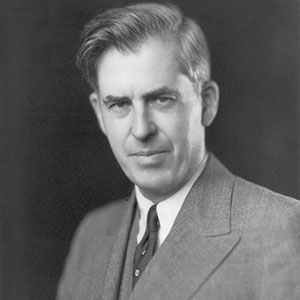Henry Agard Wallace served as the 33rd Vice President of the United States under Franklin D. Roosevelt. He is often referred to as the first “working” vice president, which reflects the amount of executive authority FDR delegated to Wallace.
Early Life and Entry into Politics
Henry Agard Wallace was born in 1888, in Adair County, Iowa. After graduating from Iowa State College in 1910, Wallace went to work for his family’s magazine, Wallace’s Farmer. He rose to become its editor in 1921. Wallace also experimented in plant genetics, which he used to establish the very successful Hi-Bred Corn Company.
While his family was staunchly Republican, Wallace broke with family tradition and joined the Democratic party. In 1933, President Franklin D. Roosevelt appointed Wallace as his Secretary of Agriculture. In this role, Wallace played a central role in drafting and administered several New Deal programs, including the Agricultural Adjustment Act of 1933, which aimed to stabilize farm prices and production. He served as Secretary of Agriculture for the first two terms of FDR’s presidency.
Vice-Presidency
After deciding to seek an unprecedented third term in office, FDR also determined that he needed a new vice president. Without consulting with Democratic party leaders, he tapped Wallace for the job. Roosevelt was confident that if he could not fulfill his term, Wallace would continue to push the New Deal forward. When the delegates objected to his choice, Roosevelt made it clear that “they will go for Wallace or I won’t run, and you can jolly well tell them so.”
FDR and Wallace easily won the election. Once in office, Wallace assumed a number of important responsibilities, prompting the press to refer to him as “Mr. Assistant President.”
Wallace chaired the Economic Defense Board, the Supply Priorities and Allocations Board, and the Board of Economic Warfare.
As the election of 1944 approached, Democratic leaders actively campaigned against Wallace’s re-nomination. In large part because FDR failed to come to his defense, the delegates at the Democratic National Convention nominated Harry S. Truman as Roosevelt’s running mate. In recognition of the fact that Wallace continued to campaign on behalf of Roosevelt, he appointed Wallace to the position of Secretary of Commerce.
Later Years
Just 82 days after Wallace left office as vice president, President Roosevelt died, and Harry Truman assumed the presidency. Once in office, Truman adopted a hardline stance against the Soviet Union. Wallace strongly disagreed with the foreign policy decision and publicly spoke out against it during a public speech. Even though Wallace has cleared his remarks with President Truman, he fired Wallace as Secretary of Commerce.
In 1948, Wallace ran for president on the Progressive ticket. He lost to Truman and retired from public office. After returning to farming for many years, Wallace died in 1965.









